Join More Than 50,000+ Subscribers and get latest camera news and rumors
NEW CAMERA VIDEOS ON YOUTUBE
|
By admin, on August 31st, 2012
Canon EOS C100
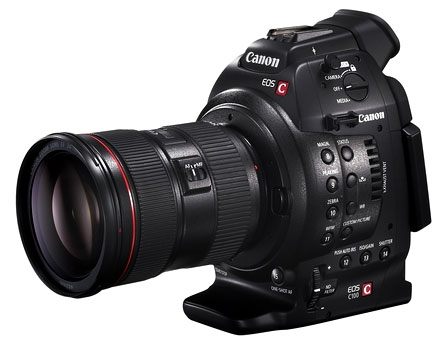 With Canon’s Super 35mm 8.3MP Bayer-filtered CMOS sensor at its core, the EOS C100 combines exceptional image quality with a design approximately 15% smaller than the advanced EOS C300. The camera’s powerful imaging system enables the same processing as three-chip RGB systems, delivering exceptional colour, wide dynamic range and proven low light performance, while extensive NLE support makes it suitable for a wide range of users and production purposes. With Canon’s EF mount users have immediate access to over 60 class-leading EF lenses, as well as the freedom to experiment with the company’s expanding EF Cinema Lens line-up. With Canon’s Super 35mm 8.3MP Bayer-filtered CMOS sensor at its core, the EOS C100 combines exceptional image quality with a design approximately 15% smaller than the advanced EOS C300. The camera’s powerful imaging system enables the same processing as three-chip RGB systems, delivering exceptional colour, wide dynamic range and proven low light performance, while extensive NLE support makes it suitable for a wide range of users and production purposes. With Canon’s EF mount users have immediate access to over 60 class-leading EF lenses, as well as the freedom to experiment with the company’s expanding EF Cinema Lens line-up.
Canon EOS C100 – key features :
- 8.3MP Super 35mm CMOS sensor; Full HD
- High sensitivity, low noise
- 24Mbps AVCHD to SD cards
- Automatic shooting functions
- Interchangeable EF lenses
- Canon Log Gamma
- Compact, modular, lightweight
- Professional audio
- Seamless workflow integration
- CPS video support
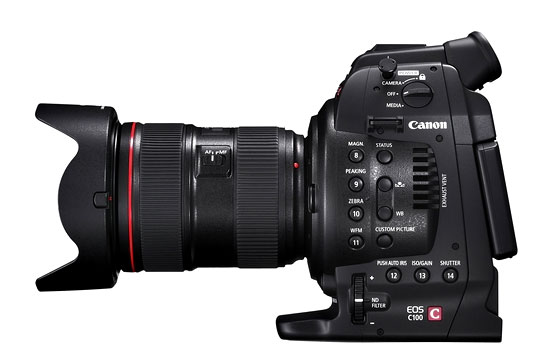 Its advanced imaging system utilises the widely-used AVCHD codec, with the CMOS sensor recording 1920×1080 (Full HD) resolution video to SD cards at 24Mbps with 4:2:0 colour sampling – delivering sharp, vivid, professional-quality video. Uncompressed video can also be output directly to external recorders via an integrated HDMI terminal, complete with embedded timecode data. Its advanced imaging system utilises the widely-used AVCHD codec, with the CMOS sensor recording 1920×1080 (Full HD) resolution video to SD cards at 24Mbps with 4:2:0 colour sampling – delivering sharp, vivid, professional-quality video. Uncompressed video can also be output directly to external recorders via an integrated HDMI terminal, complete with embedded timecode data.
EOS C100 allows users to capture high quality images for a range of creative outputs. Support for 24/25/30p and 50/60i frame rates offers flexibility, and an ISO range of 320-20,000 provides extensive exposure control and low noise in all lighting conditions.
Additionally, support for continuous, automatic focus and iris adjustment will be added by a firmware update in 2013, providing fast, smooth performance when used with specified models in Canon’s range of EF Stepper Motor (STM) lenses.
Canon EOS C500
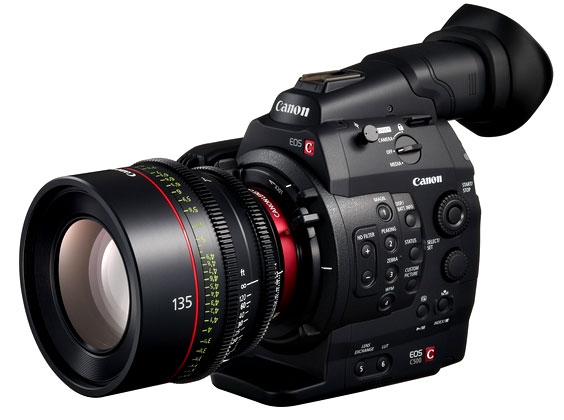 Canon EOS C500 – revolutionary 4K video capture Canon EOS C500 – revolutionary 4K video capture
Following a development announcement in April 2012, Canon today confirms the European launch of the EOS C500, a new digital cinema camera capable of 4K-resolution (4,096 x 2,160 pixels) video output. Designed for motion picture and high resolution digital production industries, the EOS C500 offers the ability to output 4K-resolution images as RAW data for recording using an external device. The camera’s uncompressed 4K output also unleashes the full potential of Canon’s expanding range of 4K-resolution EF Cinema Lenses, while an EF mount with Cinema Lock makes it easier for operators to switch lenses during shooting.
As well as uncompressed 4K footage, the EOS C500 supports 12-bit or 10-bit RGB 4:4:4 output signals for 2K (2048 x 1080 pixels) or Full HD off-board recording – delivering rich colour and high compatibility with image processes such as chroma key positioning. The camera also supports frame rates up to 120p in both 4K and 2K modes, providing enhanced creative flexibility for high-speed (slow motion) video capture. The inclusion of Canon Log Gamma delivers the high quality video and wide exposure latitude demanded by professional cinematographers.
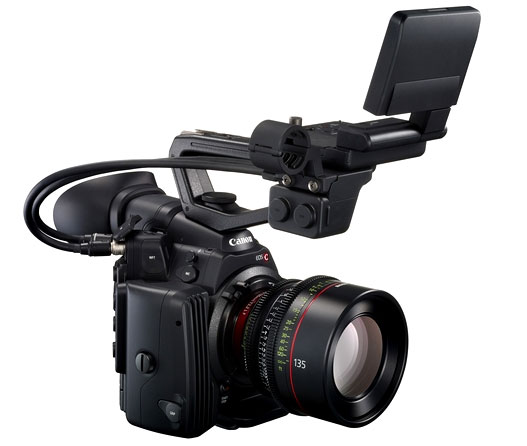 Based on the same advanced platform as the EOS C300, the EOS C500 delivers exceptional performance, incredible mobility and outstanding expandability. The availability of a PL mount variant provides support for industry-standard lenses, while the EF mount model is the first Cinema EOS camera to feature a modified EF mount with Cinema Lock. Designed as a result of user feedback, EF mount with Cinema Lock has been developed to make it simpler to swap lenses mid-shoot. Instead of the user having to rotate the lens, the new mount rotates to lock lenses into place – providing easier operation during studio and field-based shooting. Based on the same advanced platform as the EOS C300, the EOS C500 delivers exceptional performance, incredible mobility and outstanding expandability. The availability of a PL mount variant provides support for industry-standard lenses, while the EF mount model is the first Cinema EOS camera to feature a modified EF mount with Cinema Lock. Designed as a result of user feedback, EF mount with Cinema Lock has been developed to make it simpler to swap lenses mid-shoot. Instead of the user having to rotate the lens, the new mount rotates to lock lenses into place – providing easier operation during studio and field-based shooting.
New cinema zoom lenses
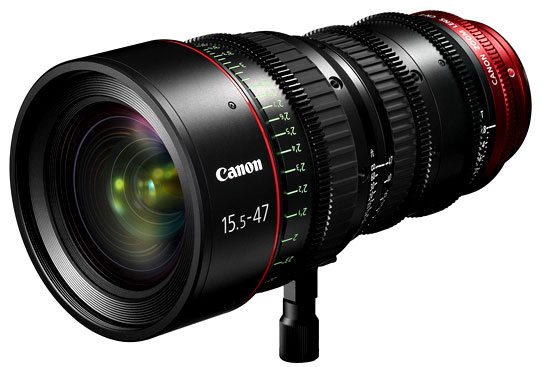 New cinema zoom lenses – flexibility, performance and value New cinema zoom lenses – flexibility, performance and value
The arrival of four new EF Cinema Lenses expands the Cinema EOS System further, with each designed to offer premium performance, mobility and competitive pricing. Two wide-angle cinema zoom lenses, the CN-E15.5-47mm T2.8 L S (EF mount) and CN-E15.5-47mm T2.8 L SP (PL mount) launch alongside two telephoto cinema zoom lenses, theCN-E30-105mm T2.8 L S (EF) and CN-E30-105mm T2.8 L SP (PL) and all offer sufficient resolution for 4K production, making them ideal for use with Canon’s EOS C500 and EOS-1D C cinema cameras – both of which support 4K video capture.
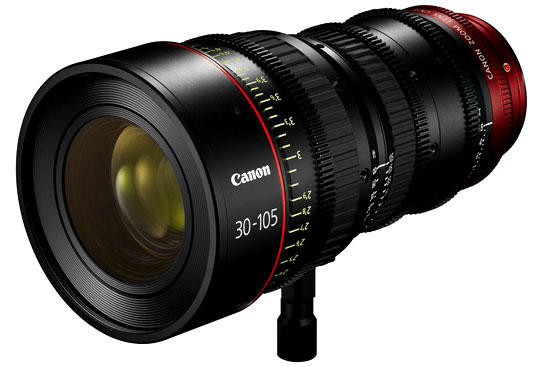
By admin, on January 14th, 2012
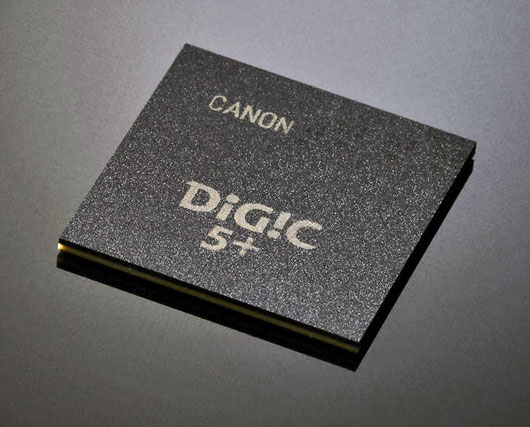 DIGIC 5 processor is six times faster than DIGIC 4 and DIGIC 5+ is three times faster than DIGIC 5, the Canon EOS 5D Mark II has a DIGIC 4 processor, Canon EOS 7D uses two separate processors, working in parallel dual DIGIC 4 processors.The New Canon S100, PowerShot G1 X both of them have a DIGIC 5, and the Canon EOS-1D X features dual DIGIC 5+ processors. DIGIC 5 processor is six times faster than DIGIC 4 and DIGIC 5+ is three times faster than DIGIC 5, the Canon EOS 5D Mark II has a DIGIC 4 processor, Canon EOS 7D uses two separate processors, working in parallel dual DIGIC 4 processors.The New Canon S100, PowerShot G1 X both of them have a DIGIC 5, and the Canon EOS-1D X features dual DIGIC 5+ processors.
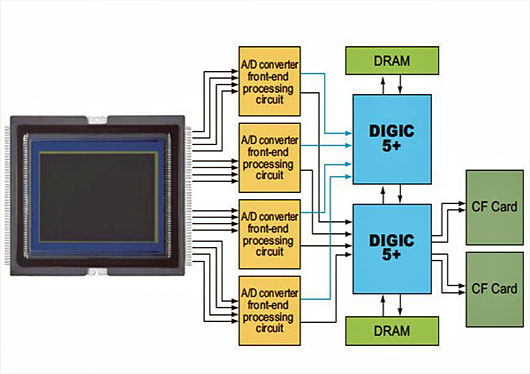 The EOS-1D X sensor has a 16-channel, dual line readout, compared to the 8-channel, single line design in the previous generation of chips. So 1D X have more pipes to get data from sensor, you get 12fps in RAW+JPEG mode and 14-bit color on every image and ISO 100 to 51,200 (standard ISO range) on the EOS-1D X — without any ISO expansion applied. The EOS-1D X sensor has a 16-channel, dual line readout, compared to the 8-channel, single line design in the previous generation of chips. So 1D X have more pipes to get data from sensor, you get 12fps in RAW+JPEG mode and 14-bit color on every image and ISO 100 to 51,200 (standard ISO range) on the EOS-1D X — without any ISO expansion applied.
By admin, on December 7th, 2011
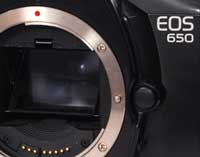 According to canon rumors [CR2] the expected arrival date of canon 650D / T4i is before CP+ show in feb 2012, The upcoming rebel will have a new 24mp APS-C sensor and DIGIC 5 processor, The DIGIC 5+ won’t be used. Users can see some standard upgrade on ISO performance, HD Video quality and other creative controls. According to canon rumors [CR2] the expected arrival date of canon 650D / T4i is before CP+ show in feb 2012, The upcoming rebel will have a new 24mp APS-C sensor and DIGIC 5 processor, The DIGIC 5+ won’t be used. Users can see some standard upgrade on ISO performance, HD Video quality and other creative controls.
But the news is still not confirmed, canon may keep its new 24 megapixel CMOS sensor for canon 70D or 8D and 650D / T4i may come with old image sensor(18 megapixel) and new DIGIC 5 image processor.
By admin, on October 15th, 2011
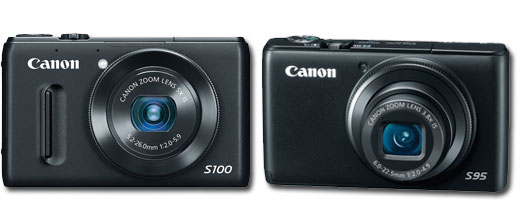
Canon S100 vs. Canon S95 Specification comparison review, Which one is more better and why? See the Specification comparison table and review(below).
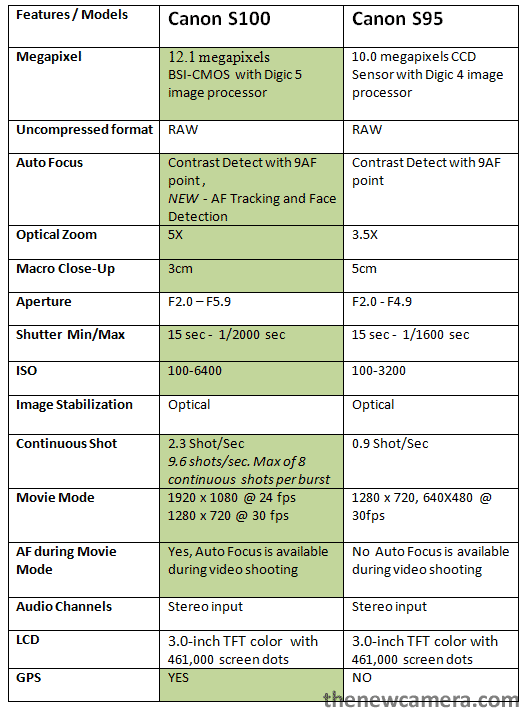
Canon S100 vs Canon S95:
Sensor: Canon S100 have new 12 megapixel CMOS Sensor with higher sensitivity, you get more megapixel and low noise.
Lens: The PowerShot S100 features 5X optical zoom and F2.0 – F5.9 Aperture, high performance lens developed and manufactured using the same methods and expertise as Canon’s leading EF lenses,
Image processor: New Digic V image processor of S100 is 6X faster and produces 75% less noise compared to Digic IV images processor of S95.
Improved low light performance: Due to Digic V image processor and new CMOS sensor, At ISO 1600 the Canon S100 creates 75% less noise compared to Canon S95.
New Intelligent IS – Canon’s highly-effective 4-stop optical Image Stabilizer to counter camera shake in stills and Full HD movies, Intelligent IS automatically identifies the scene and adapts the optical Image Stabilizer settings for optimal compensation.
Full HD with AF: Canon S100 features Full HD Video Recording at 24p, 5.0x optical zoom, AF can be used during video capture, while Dynamic IS and Powered IS mode within Intelligent IS counteract camera shake when recording whilst moving, or when using the zoom.
GPS: Canon PowerShot S100’s integrated GPS, supplied Map Utility software which integrates with Google Map.
LCD: Same LCD Screen as S95.
Conclusion: Upgrade from S95 to S100 is highly recommended.
Buy Canon S100 from Amazon , Amazon UK, B&H Store and Adorama.
See more – Canon SX40 HS vs Canon SX30 IS
By admin, on September 15th, 2011
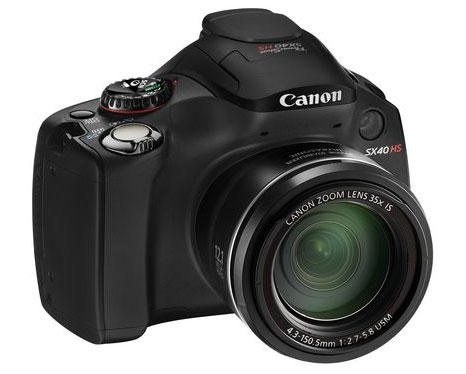 Canon SX40 HS camera comes with a new 12megapixel CMOS sensor, increased ISO sensitivity up-to 3200, New Digic V image processor with 6X faster speed and creates 75% less noise compared to old Digic IV processor used in Canon SX 30 IS camera. The New Canon SX 40 HS camera Record Full HD (1080p) movies at 24fps with stereo sound. Canon SX40 HS camera comes with a new 12megapixel CMOS sensor, increased ISO sensitivity up-to 3200, New Digic V image processor with 6X faster speed and creates 75% less noise compared to old Digic IV processor used in Canon SX 30 IS camera. The New Canon SX 40 HS camera Record Full HD (1080p) movies at 24fps with stereo sound.
Features Overview
- 35x ultra wide-angle zoom with USM
- Image Stabilizer (4.5-stop). Intelligent IS
- HS System (12.1 MP) with DIGIC 5
- Full HD, HDMI
- 6.8 cm (2.7″) vari-angle LCD, EVF
- Smart Auto, Multi-area WB
- High-speed Burst HQ
- Manual modes
- Zoom Framing Assist
- Range of accessories
New in SX 40 HS
HS System with DIGIC 5
A powerful combination of the latest DIGIC 5 image processor and high-sensitivity CMOS sensor, the HS System lets you shoot with low noise and high image quality even in low light – reducing the need for flash or tripod, freezing motion without blur and increasing available flash range
Smart Auto with Multi-area WB
Smart Auto is truly automatic, allowing the camera to detect from 32 different scenes (21 in movies), ensuring optimum results. Multi-area White Balance captures scenes in their natural colours even when illuminated by multiple types of light.
High-speed Burst HQ
Capture split second action in full 12.1 MP resolution, at up to 10.3 shots/sec. for up to 8 shots, using High-speed Burst HQ mode.
Zoom Framing Assist
Zoom Framing Assist helps you keep track of a distant subject when shooting with maximum zoom. At the press of a button it quickly zooms out of the scene – so you can relocate the subject – zooming back in the moment it’s released.
Range of accessories and hot-shoe
An optional Lens Filter Adapter lets you attach 67mm lens filters from Canon’s EOS range. A hot-shoe allows use of Canon Speedlite EX flash units to increase flash range and expand your creativity.
By admin, on September 15th, 2011
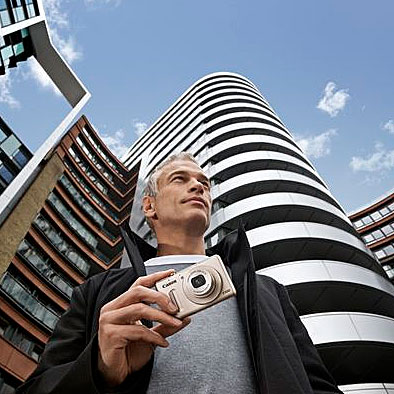 Yes, finally canon new image processor comes out with Canon S100 and Canon SX 40 HS Compact camera, The new DIGIC 5 processor analyses four times more image data to accurately produce each pixel of the image, which delivers more detail and more realistic colours. Image data is also processed six times faster compared to its predecessor DIGIC 4. The increased processing power, combined with improved noise reduction algorithms, results in highly detailed images with up to 75% less noise compared to the previous DIGIC 4-based models. Yes, finally canon new image processor comes out with Canon S100 and Canon SX 40 HS Compact camera, The new DIGIC 5 processor analyses four times more image data to accurately produce each pixel of the image, which delivers more detail and more realistic colours. Image data is also processed six times faster compared to its predecessor DIGIC 4. The increased processing power, combined with improved noise reduction algorithms, results in highly detailed images with up to 75% less noise compared to the previous DIGIC 4-based models.
New fetures in Digic V processor
Multi-area White Balance
The new DIGIC 5 processor powers a new feature, Multi-area White Balance. Most digital cameras set a white balance based on the most dominant light source within the scene. However, if there are multiple light sources present, then this approach can lead to an inconsistency in the way that colour is represented. For example, if flash is used to illuminate the main subject within a tungsten-lit environment, then the subject will look natural but the surroundings can look overly “warm” in comparison – a result of the different colour temperature of the flash and tungsten lights.
|
KEEP THIS BLOG ALIVE - Support New Camera Buy Canon Lenses, Buy Music CD or Digital Camera at amazon it helps this site, and you do not pay anything extra, it is just a way to help support this site.

|
 With Canon’s Super 35mm 8.3MP Bayer-filtered CMOS sensor at its core, the EOS C100 combines exceptional image quality with a design approximately 15% smaller than the advanced EOS C300. The camera’s powerful imaging system enables the same processing as three-chip RGB systems, delivering exceptional colour, wide dynamic range and proven low light performance, while extensive NLE support makes it suitable for a wide range of users and production purposes. With Canon’s EF mount users have immediate access to over 60 class-leading EF lenses, as well as the freedom to experiment with the company’s expanding EF Cinema Lens line-up.
With Canon’s Super 35mm 8.3MP Bayer-filtered CMOS sensor at its core, the EOS C100 combines exceptional image quality with a design approximately 15% smaller than the advanced EOS C300. The camera’s powerful imaging system enables the same processing as three-chip RGB systems, delivering exceptional colour, wide dynamic range and proven low light performance, while extensive NLE support makes it suitable for a wide range of users and production purposes. With Canon’s EF mount users have immediate access to over 60 class-leading EF lenses, as well as the freedom to experiment with the company’s expanding EF Cinema Lens line-up. Its advanced imaging system utilises the widely-used AVCHD codec, with the CMOS sensor recording 1920×1080 (Full HD) resolution video to SD cards at 24Mbps with 4:2:0 colour sampling – delivering sharp, vivid, professional-quality video. Uncompressed video can also be output directly to external recorders via an integrated HDMI terminal, complete with embedded timecode data.
Its advanced imaging system utilises the widely-used AVCHD codec, with the CMOS sensor recording 1920×1080 (Full HD) resolution video to SD cards at 24Mbps with 4:2:0 colour sampling – delivering sharp, vivid, professional-quality video. Uncompressed video can also be output directly to external recorders via an integrated HDMI terminal, complete with embedded timecode data. Canon EOS C500 – revolutionary 4K video capture
Canon EOS C500 – revolutionary 4K video capture Based on the same advanced platform as the EOS C300, the EOS C500 delivers exceptional performance, incredible mobility and outstanding expandability. The availability of a PL mount variant provides support for industry-standard lenses, while the EF mount model is the first Cinema EOS camera to feature a modified EF mount with Cinema Lock. Designed as a result of user feedback, EF mount with Cinema Lock has been developed to make it simpler to swap lenses mid-shoot. Instead of the user having to rotate the lens, the new mount rotates to lock lenses into place – providing easier operation during studio and field-based shooting.
Based on the same advanced platform as the EOS C300, the EOS C500 delivers exceptional performance, incredible mobility and outstanding expandability. The availability of a PL mount variant provides support for industry-standard lenses, while the EF mount model is the first Cinema EOS camera to feature a modified EF mount with Cinema Lock. Designed as a result of user feedback, EF mount with Cinema Lock has been developed to make it simpler to swap lenses mid-shoot. Instead of the user having to rotate the lens, the new mount rotates to lock lenses into place – providing easier operation during studio and field-based shooting. New cinema zoom lenses – flexibility, performance and value
New cinema zoom lenses – flexibility, performance and value



 According to
According to 


 Yes, finally canon new image processor comes out with
Yes, finally canon new image processor comes out with 



